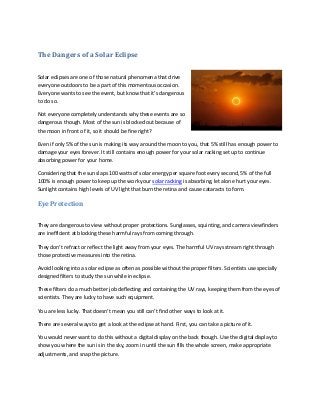
The Dangers of a Solar Eclipse
- 1. The Dangers of a Solar Eclipse Solar eclipses are one of those natural phenomena that drive everyone outdoors to be a part of this momentous occasion. Everyone wants to see the event, but know that it’s dangerous to do so. Not everyone completely understands why these events are so dangerous though. Most of the sun is blocked out because of the moon in front of it, so it should be fine right? Even if only 5% of the sun is making its way around the moon to you, that 5% still has enough power to damage your eyes forever. It still contains enough power for your solar racking set up to continue absorbing power for your home. Considering that the sun slaps 100 watts of solar energy per square foot every second, 5% of the full 100% is enough power to keep up the work your solar racking is absorbing, let alone hurt your eyes. Sunlight contains high levels of UV light that burn the retina and cause cataracts to form. Eye Protection They are dangerous to view without proper protections. Sunglasses, squinting, and camera viewfinders are inefficient at blocking these harmful rays from coming through. They don’t refract or reflect the light away from your eyes. The harmful UV rays stream right through those protective measures into the retina. Avoid looking into a solar eclipse as often as possible without the proper filters. Scientists use specially designed filters to study the sun while in eclipse. These filters do a much better job deflecting and containing the UV rays, keeping them from the eyes of scientists. They are lucky to have such equipment. You are less lucky. That doesn’t mean you still can’t find other ways to look at it. There are several ways to get a look at the eclipse at hand. First, you can take a picture of it. You would never want to do this without a digital display on the back though. Use the digital display to show you where the sun is in the sky, zoom in until the sun fills the whole screen, make appropriate adjustments, and snap the picture.
- 2. Photography You should be able to see the moon blocking a portion of the sun. Since a picture says a thousand words, you can help preserve that moment of your life forever with it. Obviously, the higher quality camera you own, the better the picture you’ll get from it. Second, you can cut a hole in a piece of paper, hold that up to the sun and layout another piece of paper in the first paper’s shadow. The image of the sun will shine through the hole creating the image of the sun on the other piece of paper. When you examine the image here, you can see the shadow of the sun blocking all of the light from coming through. Although it’s not quite as exciting as seeing the eclipse yourself, you get a very similar image without the eye damage. There’s always a clever way to see the phenomenon safely. Avoid the conventional ones that put your eyes in direct line of sight of the sun’s rays. Your solar racking and panels won’t feel a difference in the energy they absorb. What are the odds that your human eyes are going to do any better? No thirty seconds of staring in wonder will ever be worth your long-term eyesight. Photo Credit: Kevin Baird,